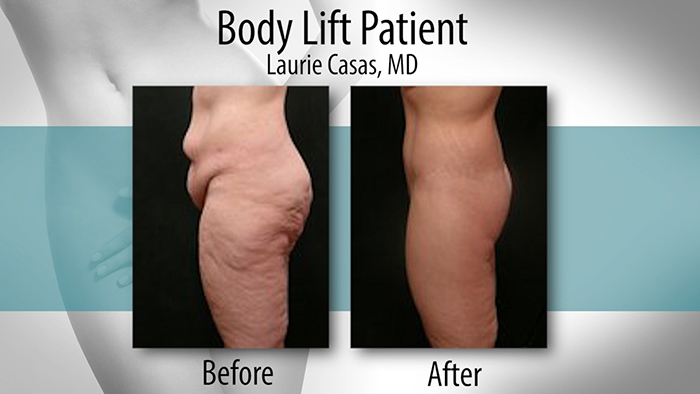Ever wondered why those lunges just won’t work and your butt never seems to change regardless of how many miles you run and how many Pilates classes you go to? Diet and exercise are essential to health and well-being but sometimes, hitting the gym is not enough and can actually discourage patients from continuing a healthy routine.
Dr. Laurie Casas, a board certified plastic surgeon in Glenview, Illlinois, sees a lot of patients who she says, “Simply come to see me because they have saggy bottoms!” Weight gain and weight loss just as a fact of life or product of pregnancy is hard on a woman’s body producing areas of saggy, excess skin that are very stubborn and unlikely to go away without a surgical intervention. Tummy tucks, or abdominoplasty procedures, have been around for ages. Most people are familiar with the procedure and understand what a tummy tuck can do, addressing muscle wall separation in the belly, deep compartmental fat and excess skin. But what about the buttocks and outer thighs? Can they be lifted too?
by Terrye Tebbetts
and Laurie Casas, MD
Seeing the Lower Body as a Whole
A lower body lift addresses all these areas of concern – not just the belly. “I do a tummy tuck in front and then go around the back and dissect down the leg allowing me to contour the outer thigh,” says Casas, “then, that area in the back that you can grab, I use that as an autologous fat graft and use it to give a nice shape to the buttocks.” Often patients will seek out liposuction as a way to address their “ugly swim suit legs” but if there is loose excess skin, liposuction will only make matters worse leaving more dimpling and more loose skin. Using this unique surgical view of the lower body as a whole and not just focusing on the tummy gives women new options to address the signs of aging and gravity in the lower body – belly, legs and butt – that lunges and squats just won’t touch.

Lifestyle and Surgery work together
A lower body lift is a big procedure and Dr. Casas says that if a woman wants to undergo this procedure, they really need to be in the best shape of their lives. Ideally a woman should be within fifteen pounds of her ideal weight and have maintained it for at least three months before considering surgery. Patients considering this type of surgery must also be nonsmokers and have a should have a relatively healthy lifestyle. In other words, diet, exercise, nutrition and skin care are very important precursors to surgical success. “You have to be ready, and then you have to maintain it,” says Casas, making lifestyle changes essential to good, sustainable, long term results.
The Journey
Lower body lifts can range in surgical time from 2 ½ – 4 hours depending on the scope of the operation. Patients will often wear surgical girdles or compression garments for several weeks following surgery. Although patients resume normal activity fairly quickly, seeing the final result will take time. A body transformation is a team effort and a journey that Dr. Casas goes on with her patients. From the beginning and defining goals, to the actual surgery, to the recovery process, seeing the final transformation takes time. “Seeing a patient right after surgery isn’t the most exciting part, it is the relationship I develop with the patient,” says Dr. Casas, “it’s the journey.”














Facebook
Twitter
Instagram
YouTube
RSS